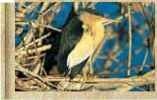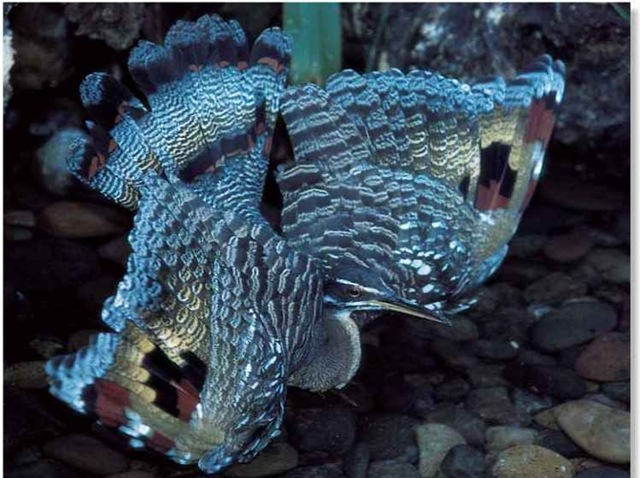ORDER
Gruiformes
FAMILY
Eurypygidae
GENUS & SPECIES
key features
A heronlike wading bird that lives and feeds along tropical forest watercourses Camouflaged by its plumage until it reveals brilliant wing “eye spots” in a defensive display
A specialist predator of fish and other aquatic life, it also hunts among the leaf litter
where in the world?
Found in lowland tropical forests in Central and South America, from southern Mexico to Bolivia and the Amazon Basin
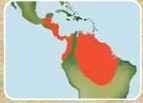
LIFECYCLE
The sun bittern lives a sedate life skulking along Central and South American streams, but reacts in a flash to threats by “switching on” a spectacular plumage display.
HABITAT
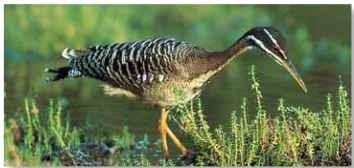
A Open access
The sun bittern often strays into clearings.
The sun bittern is primarily a bird of lowland rainforests, although in Venezuela it occurs at altitudes of 6,600′. It always
lives by watercourses — slow rivers in the lowlands, fast streams in the mountains — with boulders and fallen branches for perches.
The sun bittern selects nesting and roosting sites in open areas beneath a closed canopy, where it enjoys shelter from the sun, a clear view of predators and an arena for its breathtaking display
The sun bittern occasionally washes food items in the river before eating them or presenting them to nestlings.
A brooding sun bittern often sways its body like a snake and hisses to threaten intruders.
Sun bittern fledglings practice the eye-spot display from the age of three weeks.
FOOD & HUNTING
The sun bittern’s diet includes a wide range of animal prey most of it aquatic. The menu includes spiders, adult and larval flies, dragonflies, water beetles, cockroaches, snails, crabs, shrimps and worms. Other prey includes frogs, toads and small fish.
The sun bittern stalks slowly and silently along the water’s edge or wades in the shallows. It often freezes, head tilted to one side and one leg raised. Once within striking distance of a potential meal, the bird whips its neck forward as quick as lightning to seize its victim with almost unerring accuracy.
In areas where the water is too deep for wading, the sun bittern hunts on the ground, snapping up frogs, spiders and lizards.Adults feed nestlings on freshly killed prey, recovering and presenting again any morsels dropped by their young.
ONCE BITTERN…
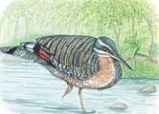
Shore patrol…
The sun bittern wades stealthily through the shallows, peering intently into the water for any sign of a potential meal.

The strike…
The bird startles a small fish from its riverbed niche.With a swift dart, the sun bittern dips its head into the water and traps its victim.
BEHAVIOR
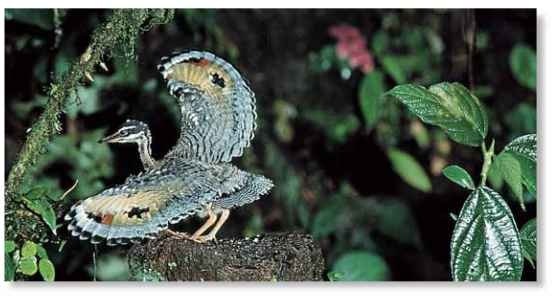
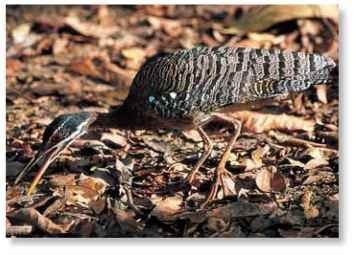
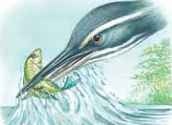
The catchy
Caught in the grip of the slender but powerful bill, the fish has no chance of escape.The sun bittern swallows its prize head first.
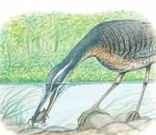
Second course
A freshwater crab meets its end in similar style.The bird swallows it whole; its digestive system can dissolve the shell.
BREEDING
The sun bittern’s dramatic plumage plays a role in courtship rituals, which include gliding flights and loud hacking calls.The pair breeds early in the rainy season, when mud becomes available for nest-building. Both sexes construct the heap of moss, leaves, roots and grass, using the mud to secure it to a low bough.The female usually lays two eggs, which the pair incubates for up to 30 days.
The chicks hatch with a coat of down and remain in the nest for at least three weeks, fed and guarded by their parents.
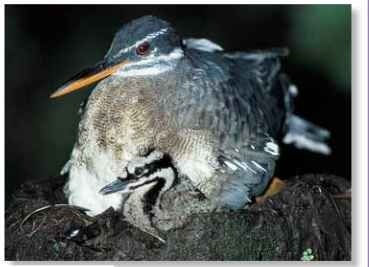
A Slow starter Nestling development speeds up after 7—10 days.
Hard stare The large, colorful wing patches resemble a pair of eyes and scare off predators.
The sun bittern is generally ^ solitary except when sharing nest duties with its partner It is ever wary as it stalks elegantly about its range. Ratherthan flee instantly from predators or nestthiefs, such as the ocelot, it adopts its defense display Fanning out its wing and tail feathers, the bird angles them to present the dramatic markings on its wings. The overall impression is that of a huge animal with startling eyes; this is usually enough to frighten off most enemies. The bittern may sustain this posture for over a minute before suddenly folding its plumage and melting into the shadows on the forest floor.
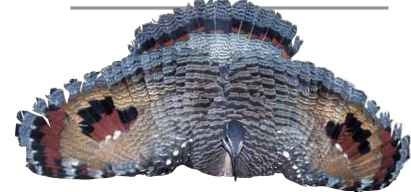
CONSERVATION
Although not common, the sun bittern is not listed as endangered. Like many tropical forest dwellers, however, it is vulnerable to the effects of deforestation.Where large swaths of trees are felled, soil is washed away. Streams often become more cloudy, making it harder for birds like the sun bittern to find food.
PROFILE
Sun Bittern
With its soft-feathered wings folded, the sun bittern looks a little like a heron, but its defensive display reveals a blaze of rich color and pattern.

CREATURE COMPARISONS
The name bittern is generally used for birds of the heron family that live in waterside vegetation. Like the sun bittern, these true bitterns use a combination of stealth and camouflage to catch prey.The Old World bittern (Botaurus stellaris), one of the largest, hunts fish and frogs in reedbeds. In contrast to the sun bittern’s whistling call, the Old World bittern utters a powerful boom audible over 1 mile away
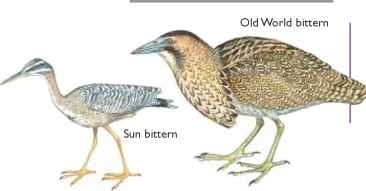
| vital statistics | |
| Weight | 6-8.5 oz. |
| Length | 17.5-19″ |
| WINGSPAN | 24-28″ |
| Sexual Maturity | 1-2 years |
| Breeding Season | Start of the rainy season |
| Number of Eggs | 2 |
| Incubation PERIOD |
29-30 days |
| Fledging Period | 21 days |
| Breeding Interval Typical Diet |
1 year Small fish, frogs, insects and spiders, |
| Lifespan | Unknown |
Related species
• The sun bittern is the sole species in its family; 3 subspecies are distinguished by small plumage differences.The sun bittern is unrelated to the Old World bittern and little bittern, Ixobrychus minutus (below), members of the heron family Ardeidae.
